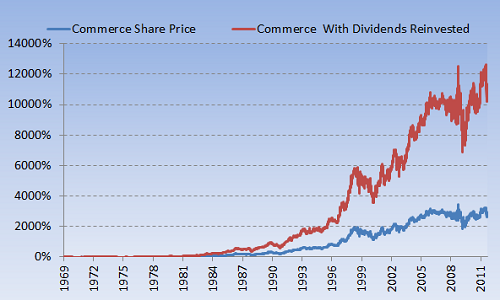The Extraordinary Power of Commerce Bancshares' Dividends
I took my first investing class as a teenager, and one moment stands out in my memory. A fellow student asked the instructor, a stockbroker, about dividends.
"Dividends?" he asked. "I'm trying to make my clients wealthy. You don't do that waiting for tiny checks in the mailbox every quarter."
Even then, I had enough horse sense to know he was wrong. Paying attention to dividends is exactly how you become wealthy over time.
Wharton professor Jeremy Siegel made a wonderful discovery in his book The Future for Investors. The greatest long-term returns typically don't come from the most innovative companies, or even companies with the highest earnings growth. They come from companies that happen to crank out dividends year after year. Simply put, since the 1950s, "the portfolios with higher dividend yields offered investors higher returns."
Market commentary regularly centers around price gyrations, yet dividends have historically accounted for more than half of total returns.
Reinvest those dividends, and the gains get even greater. Take Commerce Bancshares (NAS: CBSH) , for example. Since the late 1960s, the company's share price has increased 2,800%. But add in reinvested dividends, and total returns jump to nearly 11,000%:

Source: Capital IQ, a division of Standard & Poor's.
There's no ambiguity here: Over time, Commerce's share appreciation alone has paled in importance to the power of its reinvested dividends. The results are similar for other banks like JPMorgan Chase (NYS: JPM) and Wells Fargo (NYS: WFC) ; reinvested dividends skew both companies' total returns dramatically higher. If you're a long-term shareholder, don't worry about daily share wobbles. Devote your attention to those dividend payouts, and your commitment to reinvest them.
And how do Commerce's dividends look? At 2.4%, its yield is above the market average. The company has paid a dividend for at least 43 years, raising that payout in all but one year. Commerce was one of only a few large banks that made it through the 2008 financial crisis without accepting TARP bailout funds, and thus was never forced to all-but-eliminate its dividend, as many of its peers were. CEO David Kemper said turning down TARP "was one of the best decisions of my adult life." It shows. Very few banks have anywhere near the kind of shareholder returns Commerce has put up over the past ten years. Most of that is thanks to dividends.
To earn the greatest returns, get your priorities straight. What the market does is less important than what your company earns. What your company earns is less important than how much it pays out in dividends. And what it pays out in dividends is less important than whether you reinvest those dividends.
Add Commerce Bancshares to My Watchlist.
At the time thisarticle was published Fool contributorMorgan Houseldoesn't own shares in any of the companies mentioned in this article. Follow him on Twitter @TMFHousel.The Motley Fool owns shares of JPMorgan Chase. The Fool owns shares of and has created a ratio put spread position on Wells Fargo. Try any of our Foolish newsletter services free for 30 days. We Fools may not all hold the same opinions, but we all believe that considering a diverse range of insightsmakes us better investors. The Motley Fool has a disclosure policy.
Copyright © 1995 - 2011 The Motley Fool, LLC. All rights reserved. The Motley Fool has a disclosure policy.

